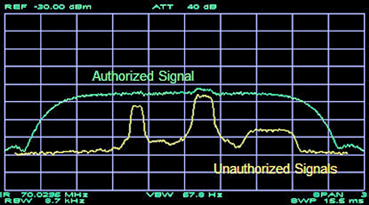Numerous systems, capabilities and technologies exist, or are in active research and development, toward the end goal of protected SATCOM.

Steve Williams, left and Chris Badgett
Many are already in dual DoD/Commercial use, or are rapidly converging for use within both domains. Many align with best practices for end-to-end protected SATCOM. These include:
• Designed-in Protection
• Ground System Protection
• Signal Monitoring
• Signal Geolocation
• Training
• Self-Testing
• Integrated Solutions
Designed-In Protection
RF (Radio Frequency) link protection starts long before satellites are launched or ground stations are designed. Channel Simulators, Transponder Simulators and Satellite Signal Emulators can generate nominal and worst-case SATCOM test signals within a controlled lab environment. Using these instruments, engineers can then design, tune and test their firmware, software and hardware for unimpeded communications even under degraded signal conditions.
In the laboratory, Channel Simulators and Transponder Simulators create physics-compliant signals indistinguishable from their real world counterparts. These signals include propagation effects modeling, motion-related Doppler shift, atmospheric and multipath fading, path delay, and atmospheric noise profiles. Furthermore, these systems can simulate spacecraft equipment effects, duplicating amplitude and phase response and introducing linear and non-linear signal distortions.
These simulators, augmented with SATCOM Signal Generators, create full realism by supplying anything from perfect signals, to those impacted by multiple instances of advanced static and dynamic interference, both accidental and intentional. These instruments also generate signals perturbed by unexpected flight paths, attitude or antenna pattern issues.
High fidelity Satellite Signal Emulators accurately represent complex uplink and downlink signals, and are valuable tools for system developers, testers and trainers. These devices fully emulate complex wideband communications systems found on the emerging generation of channelized, multi-beamed HTS (High Throughput Satellite) systems, such as the WGS (Wideband Global SATCOM) constellation.
These instruments give SATCOM hardware, firmware and software designers a huge advantage during the design and test process, enabling them to develop and test equipment that will be tolerant of natural signal degradation and resilient to a broad variety of attacks on the signal.
Ground System Protection
IP traffic between ground system components and sites must be fast and reliable. However, wide area IP networks exhibit traits that can degrade performance: dropped packets, indeterminate latency, variable jitter, and packet duplication and reordering.

Exhibit 1: Advanced Spectrum Analysis with covert and overt interference detection and characterization capabilities.
To repair dropped packets, the PFEC (Packet Forward Error Correction) and IRP (Intelligent Retransmission Protocol) protocols should be used. Both protocols allow high throughput with low latency across lossy, long-haul links and give the user the flexibility to choose the best solution for each situation. Ground systems must provide extensive network performance analysis and diagnostics in addition to robust traffic protection.
Cost-effective antenna site diversity capabilities for weather conditions (e.g., rain fade), and disaster recovery are also needed. These capabilities should precisely align signals received and packetized at two different locations within just several nanoseconds to enable seamless switching between antennas, at any separation distance, without losing modem lock.
Exhibit 1: Advanced Spectrum Analysis with covert and overt interference detection and characterization capabilities.
Digital IF (Intermediate Frequency) architectures enable site diversity and resiliency by digitizing spectrum from geographically separated antennas. The digitized spectrum is then transported via IP (Internet Protocol) networks to modems at a centralized hub or processing center.
Additional capabilities for real-time network health monitoring and reporting are an important aspect of any ground station protection mechanism. Additionally, cyber-attack detection and real-time reporting via a NIAP-certified (National Information Assurance Partnership) SIEM (Security Information and Event Management) is highly desirable.

Exhibit 2.
Signal Monitoring
With well-designed and tested SATCOM systems enhanced for link protection, the first operational line of defense is continuous and advanced monitoring of the received and transmitted signals. Automatic signal monitoring must go beyond simple spectrum analyzer mask analysis of bandwidth, center frequency and power level. In-depth and real-time signal analysis must also include blind determination of modulation type, data rate, coding scheme, MER (Modulation Error Rate), EVM (Error Vector Magnitude) and BER (Bit Error Rate).
Monitoring tools that support such analysis should mathematically decompose the signal of interest, searching for unauthorized signals within the protected bandwidth that could degrade QOS (Quality of Service) as shown in Exhibit 1 on the following page.
Once these real-time measurements are complete, the monitoring system should match the results against expected values for each signal. Modulation type, data rate, center frequency, and power level differences between measured and expected values must be tolerable to the SATCOM system and the monitoring system within the boundaries of the SAA (Satellite Access Authorization).
All SATCOM modulation types should be supported by the monitoring system over high and low amplitude ranges, and narrow and wide bandwidths. This includes TDMA (Time Division Multiple Access), spread spectrum, and others, as well as the usual array of PSK (Phase-Shift Keying) (e.g., BPSK, QPSK, 8PSK, APSK, etc.) and quadrature amplitude modulation (e.g., 16QAM, 32QAM, etc.) signals.
Ideally, the monitoring system should be field-adaptable to detect and characterize new modulation types, emerging interference types and evolving intentional interference techniques.

Exhibit 3: Effective training systems can be used stand-alone, or can be connected to actual SATCOM equipment for realistic downstream equipment and systems training.
In the case of RF signals, when received or transmitted signals do not match parametric expectations, or are determined to be impacted by interference, automatic alerts and data logging must take place. This assures that already time-crunched operators are not relegated to constant vigil or control over the monitoring system.
Signal Geolocation
The fastest and most accurate geolocation systems today receive SATCOM signals via two Earth-Satellite-Earth paths. High-accuracy geolocation systems typically look at four signals during a geolocation—the interfering signal and a reference signal from a known location both passing through a primary satellite and a nearby secondary satellite in a side lobe, as shown in Exhibit 2 on the previous page.
Training
Until SATCOM networks become fully self-healing, human operators and analysts will remain those who interact with ground equipment and link protection systems, interpreting their results and taking corrective restoral actions based on their indications. Operator familiarity with these systems and the threats to them dictates how quickly and correctly they can identify and resolve problems.
As shown in Exhibit 3, SATCOM, Signals and EMI (Electromagnetic Interference) training can be conducted via software-only packages for classroom instruction, self-study “what if” experimentation, and/or war-gaming involving multiple, linked students and instructors.

Exhibit 4: An advanced modem integrates multiple Protected SATCOM functions.
By enabling deep, repeatable and continuous training strategies, operators can study SATCOM, signals, EMI and network issues, to understand exactly how their equipment will perform under challenging signal and network conditions, giving them valuable experience to hasten recognition of issues, differentiate causes, and restore operations.
Self-Test
At the command of human operators, and under computer control, Channel Simulators, Transponder Simulators, Signal Generators and SATCOM Signal Emulators can be switched into receiving system inputs where amplified antenna signals normally appear. These simulators can rapidly step through a series of pre-determined normal and degraded signals, adding interference if desired, and presenting these signals to link protection system inputs instead of the usually received SATCOM signals.
As these signals are presented, self-test software can check that each injected anomaly was properly detected and identified by the link protection capabilities. This assures proper functionality of link protection systems and algorithms, and can be an important differentiating step in isolating equipment faults, operator error, or actual link disruption.
Similarly, Geolocation Signal Simulators can be switched into geolocation system inputs in place of their usual antenna feeds. These simulators can then cycle through various combinations of satellites, ground stations, antenna patterns and other conditions to ensure anticipated geolocation results.
Integrated Solutions
An integrated solution combines primary equipment functions (e.g., a modem), with Protected SATCOM capabilities (e.g., signal monitoring and test/training, etc.) as depicted in Exhibit 4.

With a spectrally aware modem, CR (Cognitive Radio) capabilities can be pursued further. CR has applications in Ka-band HTS, and in numerous other areas. Cognitive approaches offer fresh ideas to increase spectrum utilization and efficiency. Ongoing research looks at CR applications to service future high density fixed satellite services while minimizing interference to existing users.
Protected SATCOM covers a wide area of need, with a broad set of existing and evolving solutions that leverage capabilities from and to DoD and Commercial applications.

SATCOM is a vital infrastructure element in commercial, as well as military C2 (Command and Control) and data transport applications. Due to their mission-critical nature, the function and performance of these links must be protected with great diligence, constancy and attention to detail.
www.rtlogic.com
Steve Williams is the Business Area Manager of Signals Instrumentation at RT Logic and may be reached at swilliams@rtlogic.com.
Chris Badgett is the Business Area Manager of Mission Data Processing at RT Logic and may be reached at cbadgett@rtlogic.com.
RT Logic, a subsidiary of Kratos, is the leading supplier of ground-based equipment for space/ground communications, supports 90% of US-based space missions.


